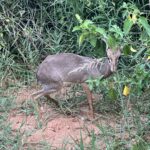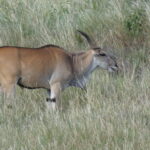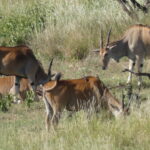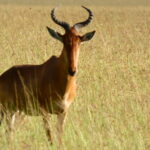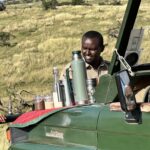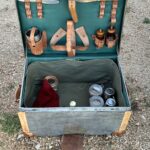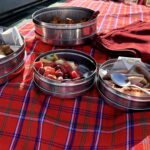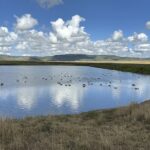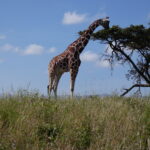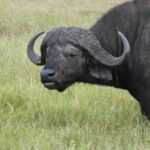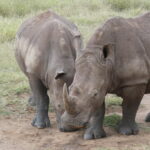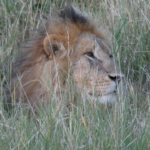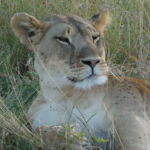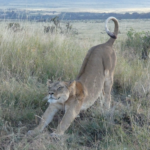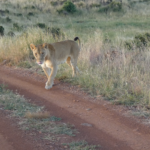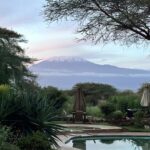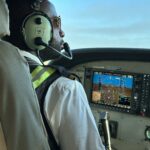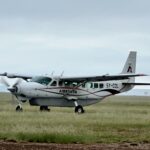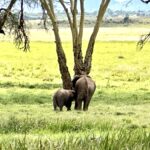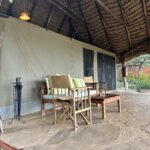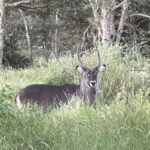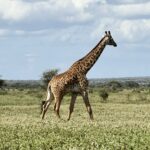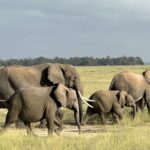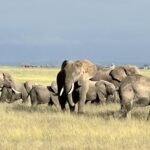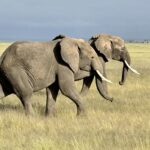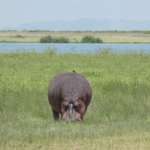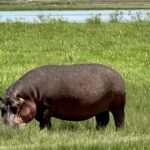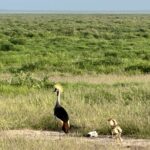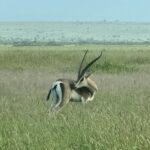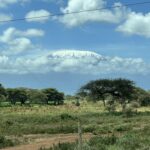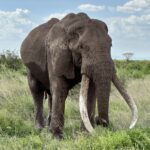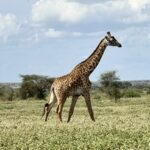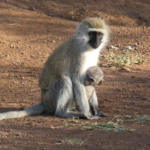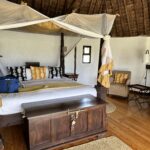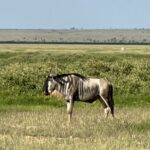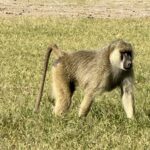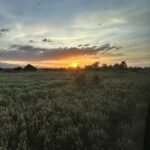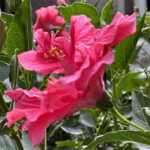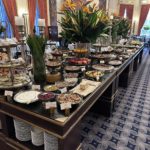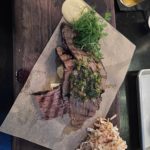What a success! We ventured out at 6:30 AM Sunday morning with Abdul at the wheel! In less than an hour, we saw 8 different animals – plus birds.
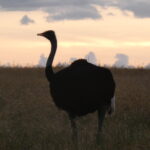
Somali ostrich
The sun was barely up when we encountered ostriches. At a height of about 7 feet and weighing in around 220 pounds, ostriches are the world’s largest birds. The common ostrich has pink legs and is commonly found in the protected grassland areas. The Somali ostrich, with its blue legs and its blue neck, is more thinly distributed in the semi arid north. both species, the larger male has handsome black and white plumage, with the female being smaller and a bit duller. They are known for their feathers, eggs, and low-cholesterol meat.
We couldn’t get a photo of a jackal running across the road ahead. He or She was just too fast. Jackals usually live in pairs rather than packs and are usually more active at dusk and dawn, however we did catch a photo in the bush. Its shrill yelping is a characteristic sound of the African night. It’s an opportunistic feeder, subsisting on small mammals and birds, and is often seen lurking near lion kills.
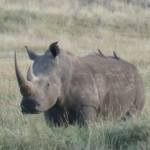
White Rhino, from the dutch meaning wide.
And, of course, we came across white rhino (differing from black rhino by the hump on its back), giraffe, elephants, zebra, and African Buffalo.
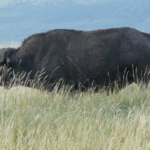
African Buffalo
The African Buffalo is similar in appearance to the Indian water buffalo and closely related to domestic cattle. It is powerfully built, can weigh up to 1,700 pounds, and heavy splayed horns. Elderly males tend to live singly or in small bachelor herds and have a reputation for being grumpy. The ones we saw were elderly, living in a bachelor herd, and had been pushed out by younger males who wanted the dominant male role in the mixed sex herd. Female calves stay with their birth herd, but males are forced out when they reach sexual maturity to preserve their genetic structure. Aggregations of more than 1000 buffalo can be found in Maasai Mara in Kenya. The African Buffalo is generally quieter than its domestic counterpart in every day communication. However, upon sighting a predator it makes an explosive snorting alarm to mobilize the rest of the herd into defensive mode.

Common Oryx
We came across the Common Oryx, an antelope about 4 feet high at the shoulder with horns that sweep straight back from the skull at the same angle as the forehead and muzzle. Usually seen in nomadic herds, it can go without water almost as long as a camel, getting all it needs from the plants it eats.

Impala
The impala is actually a relative of the wildebeest. It is an elegantly proportioned antelope with a chestnut coat and black-and-white stripes on its rump and tail. Males have magnificent black horns. They are usually found in large herds with more females and young than males. They are agile jumpers and herds often jump in all directions to confuse predators. Locals sometimes refer to them as McDonald’s since the black stripes on their rump often looks the letter M, referring, of course to the US fast food outlet.
We stopped for breakfast finding our chef and his sous chef out on a hill under a tree with the grill fired up. Agnes, our hostess, was there to serve us Kenyan coffee, a sort of oatmeal blended with nuts, banana, and raisins, healthy muffins, and breakfast burritos with sausage and bacon. Tummies full, we continued on our way.
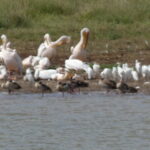 We stopped at a pond full of various varieties of birds, including Egyptian geese, white pelican, and grey heron.
We stopped at a pond full of various varieties of birds, including Egyptian geese, white pelican, and grey heron.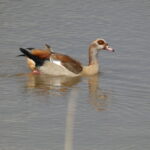
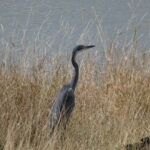
On the way back to the lodge, we asked Abdul about the training he went through to be a guide. Guiding is a profession here in Kenya. He has 6 licenses that he must renew annually and he studied tourism and the native plants, animals, and birds at the college level. In many of our sightings, he gave us the scientific name for the animal, bird, or plant. He is young, has two sons (one is 6 years old, one is 6 months old). His family lives 4 hours away, so he stays at the resort for 2 months, then goes home for 2 weeks. Sundays are usually days off, but since his family is 4 hours away (8 hours driving total), he prefers to work and save up the days for a longer period at home.
He dropped us off at the lodge and made arrangements to pick us up at 4 for our evening game drive and, perhaps a lion sighting
Afternoon Game Drive
On this afternoon’s game drive, we encountered many of the animals we had seen before. Things were a bit slow since it was overcast and rainy so the animals were hunkered down. But, we did watch a male ostrich fluff his feathers and start his dance to entice a female ostrich into a relationship. However, she wasn’t impressed and ran the other way!
We found herds of zebras crossing over to shorter grass. We noticed a family (Mom, Dad, and two babies) with the babies skipping and doing zoomies through the grass. Dad tried to regain control and order but wasn’t really successful.
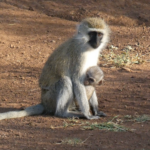
Momma and baby Vervet Monkey
We came across monkeys carrying their babies on their chests with the babies holding on tight for dear life.
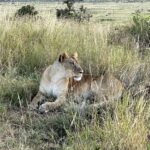
Lioness just checking things out after napping
Abdul had a feeling that as the sun came out, lions would start up to a nearby ridge to bask in the sun toward the end of the day. First we found a lioness, very calm despite how close we were. She was young, still had pink on her nose. Abdul asked us to be very still and make no sudden movements. The lions don’t have very good eyesight, perceiving everything in black and white and grey. Lions in the conservancy do not view the Land Cruisers as threats, since they see so many of them.

Let’s stretch! I am a cat after all!
The largest ground-based predator in Africa, the lion is the most sociable and least secretive of the world’s 36 cat species. It seldom takes to trees, and an adult male has a regal blonde or black mane. Lions spend up to 20 hours a day at rest. They are not very active usually during the heat of the day. But they can cover long distances at night.
The lion is the most sociable of cats living in a pride of 5 to 10 animals. That includes an adult male a few adult females and they’re offspring. Hunting is normally a team effort, undertaken by females who rely on stealth more than speed. A common strategy is for one or two lionesses to heard their prayer in the direction of other pride members lying, hidden in tall grass. Males seldom take part in a hunt, but are quick to exercise their feeding rights once a kill is made. Favored prey includes antelope, and large pride can even bring down a giraffe or buffalo.
Adult lions are most active around dusk and dawn, but cubs interact throughout the day, playing and mock fighting for hours on end. Subordinate individuals stop to greet or groom, dominant pride members, especially when they reunite after period apart. The most common call made by females as well as males is a series of far-carrying moaning grunts that first increase and then fade away. Dominant males often move separately from the main pride. This characteristic sound of the African night has a dual purpose of advertising the issuers presence to the pride and warning rivals off its territory.

Here she is strolling by the Land Cruiser on my side! I guess I am the sacrifice!

The male Lion hiding in the tall grass!
After watching the lioness as she relaxed in the grass, stretched, yawned, and twitched her ears while she flicked her tail. She got up, walked down the road a ways, then plopped down on a rock looking into the valley, calling to the rest of the pride. She got up, sauntered by our Land Cruiser (on my side) and then took off down the hill into higher grass and disappeared. We left, but Abdul was told lions had been found down the hill in that high grass. So down we went into the high grass and found two male lions, one of which we couldn’t get a good photo.

Hyena
Our Land Cruiser climbed back up the hill and we headed back to the lodge. On the way back, we saw a hyena, Africa’s second largest predator. Hyenas are highly vocal at night emitting a haunted whooo-whoop that ranks as the most definitive sound of the African night. Hyenas live in matriarchal groups of 5 to 25 and those groups are wide ranging. They are powerfully built, with a characteristic sloping back, powerful jaws, and a dog like face and snout.
We arrived back at the lodge after 7PM with headlights blazing and Abdul heavy on the accelerator.
Plans were made to take breakfast with us and leave tomorrow at 6:30 AM. Then right to dinner at the main lodge and back to tent to make preparations afterwards for the next day
On day 5 of our safari in Kenya we ran across several Lions.
 leaves, antelopes engaged in a tussle for dominance, tawny eagles, and monkeys – that took over a tree stump by the river as their colony complete with babies. But no photo, they were on the wrong side of the Land Cruiser.
leaves, antelopes engaged in a tussle for dominance, tawny eagles, and monkeys – that took over a tree stump by the river as their colony complete with babies. But no photo, they were on the wrong side of the Land Cruiser.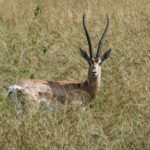 We spotted an impala that had left her herd with a baby. George explained that impalas about to give birth separate from the herd, have their baby, then return to the herd. Mom was looking around and sniffing the air, searching for their herd. During this time away from herd both mother and baby are vulnerable. The baby can keep up with its mother within minutes after being born.
We spotted an impala that had left her herd with a baby. George explained that impalas about to give birth separate from the herd, have their baby, then return to the herd. Mom was looking around and sniffing the air, searching for their herd. During this time away from herd both mother and baby are vulnerable. The baby can keep up with its mother within minutes after being born. George and Carmen, the manager of The Elephant’s Bedroom camp, had planned a surprise for us. George flew by camp and Glenn was getting alarmed, but soon we came upon a campfire, chairs, a portable bar, some snacks, park rangers and other guests and guides. We had a rum drink mixed for us and watched the sun set on our last evening in Samburu.
George and Carmen, the manager of The Elephant’s Bedroom camp, had planned a surprise for us. George flew by camp and Glenn was getting alarmed, but soon we came upon a campfire, chairs, a portable bar, some snacks, park rangers and other guests and guides. We had a rum drink mixed for us and watched the sun set on our last evening in Samburu.








